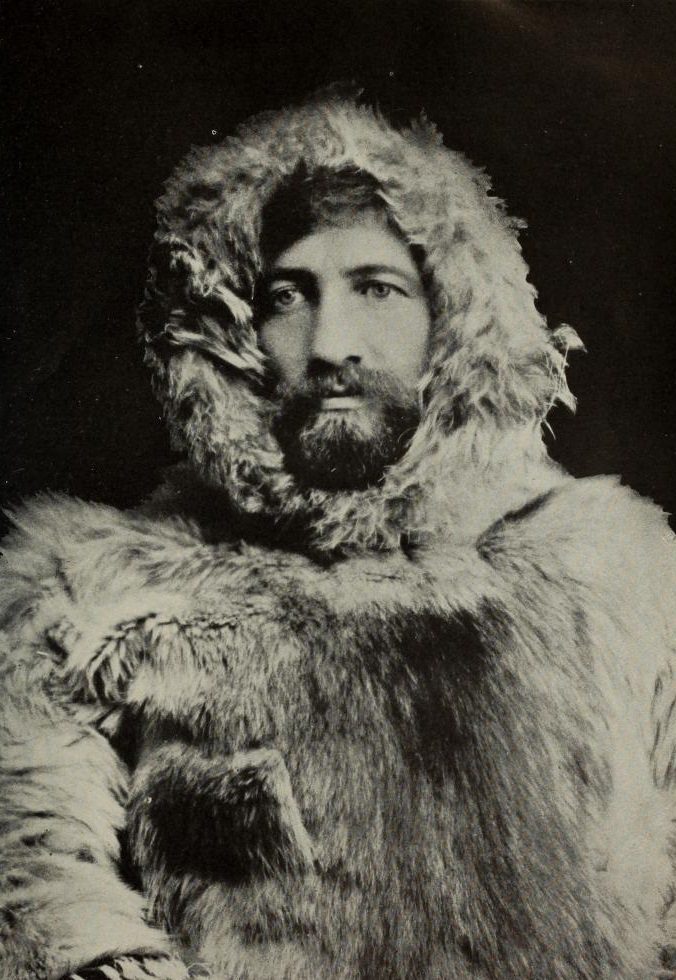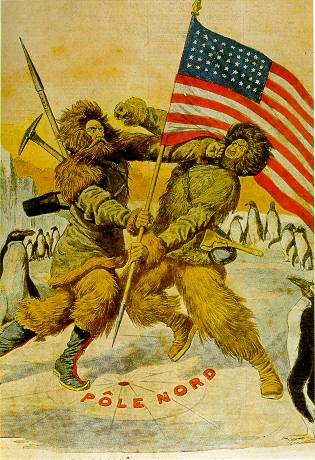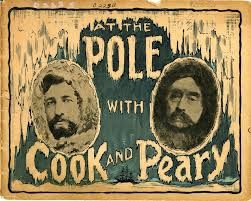James L. Franklin
Chicago, Illinois, United States
 |
| Frederick A. Cook |
Frederick A. Cook, MD (1865 – 1940) may legitimately be regarded as the first physician explorer of the Heroic Age of Antarctic Exploration. Historically that may seem to be an anomaly in that he is famously and infamously linked to the annals of Arctic Exploration. He is noteworthy for participating in the Belgian Antarctic Expedition of 1897-98 led by Adrien de Gerlache, the first expedition to overwinter within the Antarctic Circle.
Early life
Frederick Cook was born on June 10, 1865, in Hortonville, New York, and was the fourth of five children of Dr. Theodore A. Koch and his wife Magdalena. His father received his medical degree in 1850 and left Hanover, Germany, shortly after, perhaps as a consequence of his political beliefs. Dr. Koch had followed a liberal politician, Carl Schurz, who had also left Germany and was under the scrutiny of the government, and later changed his name to Cook. He settled in Sullivan County, New York, a rural area of the state far from a cholera epidemic that was occurring in New York City. The area attracted many German families seeking relief from the congestion of the city. Dr. Theodore Cook served as an examiner for the Union Army during the Civil War and returned to Sullivan County after the war to a cash-poor private practice. Frederick was five years old age when his father died suddenly of pneumonia. The years that followed were ones of hardship for the fatherless family, and his mother eventually moved the family to Brooklyn. There he and his siblings all took whatever work they could find in addition to continuing their schooling. Frederick chose to follow his father’s career in medicine, entering the College of Physicians and Surgeons at Columbia University in 1887, and transferring to New York University when Columbia moved across town. He graduated from the New York University School of Medicine in 1890. His early life was marked by tragedy. Just before graduating in 1889 he fell in love and married only to see his young bride die of peritonitis one week after delivering a child that survived only a few hours. The medical practice he opened in Manhattan also failed to thrive.
Cook and Greenland
In 1891 Cook responded to an advertisement placed by Navy Lieutenant Robert E. Peary who was recruiting a surgeon for an expedition to northern Greenland. Cook traveled to Philadelphia for an interview with Peary and his wife, Josephine Diebitsch Peary, who was to accompany Peary on his first expedition. Peary garnered much publicity in having his wife be the first woman to journey above the Arctic Circle. She subsequently gave birth to their first child in 1893, Marie Ahnightito, who was nicknamed “Snow Baby.” Early in this expedition, Cook demonstrated his medical skill by successfully treating a serious fractured leg experienced by the expedition leader Peary. He also took a keen interest in the Eskimos of the area, amassing a wealth of ethnographic information, including hundreds of photographs. The Eskimos and their way of life particularly intrigued him. During the four months of total darkness he noted the great muscular disability and apathy suffered by the members of his own party, commenting on the essential role of the sun to animal life.
Returning to New York, he presented his findings on the Greenland Eskimos at several medical meetings but ran afoul of Peary when he sought permission to publish his observations, a priority reserved by Peary as a signing condition. Although his medical practice improved after his return from Greenland, the lure of exploring Polar Regions had persisted. In 1897 he would join the Belgian Antarctic Expedition under the leadership of Lt. Adrien de Gerlache as expedition surgeon aboard the Belgica.
Cook and the Belgica Expedition
Cook met the Belgica in Rio de Janeiro in October 1897. The members were all total strangers and only the commander could speak English. The scientific staff included a magnetician, naturalist, geologist, and meteorologist. As German was spoken by several of the scientists, it was a language that allowed Cook a means of communication. The not-yet-famous Norwegian explorer Roald Amundsen was serving as first mate. Amundsen and Cook formed a lasting bond during this voyage as they shared a similar attitude toward polar exploration. Specifically they both were interested in perfecting the skills and equipment necessary for survival.
The Belgica explored the eastern coast of South America to Tierra del Fuego. Cook was able to administer medical attention to the Fuegan tribes. He continued his anthropology interests by studying of local native tribes, including the Onas, the Alcaculoofs, and the Yahgans. It was here that he met Thomas Bridges, a British missionary who had compiled a 32,000-word dictionary of the local language. Cook ultimately took charge of this dictionary on his return trip from Antarctica. There is a controversy over the handling of the dictionary as Cook did publish it as part of the report of the Belgica Expedition, but there were allegations that he tried to take credit for the work. This was in fact not the case as noted by Howard S. Abrahamson in his book, Hero in Disgrace. The dictionary was purloined by the Nazis before ultimately ending up in the British Museum.
The Belgica proceeded south along the west side of the Antarctica peninsula and ultimately became icebound, spending 147 days in total darkness. Thus, whether by accident or intention, the expedition became the first group to overwinter beneath the Antarctic Circle. During this winter Cook documented the depression and malaise experienced by all the members of the crew. Several members became severely depressed and experienced frank psychosis. Cook endeavored to treat the syndrome with daily periods of “light therapy” including bonfires that were lit on the ice surrounding the ship and exposure to artificial light aboard ship.
While in northern Greenland, Cook had observed that the Eskimos did not suffer from scurvy. This observation led to him to hypothesize that the slightly cooked meat of walrus, seal, and polar bear that was part of their diet may have prevented scurvy. The Belgica gave Cook the opportunity to put his notion to a test. When signs of scurvy began to appear in members of his crew, he instituted a regular diet of slightly cooked walrus, seal, and penguin meat. Signs of scurvy disappeared and no new cases occurred. Subsequent studies have revealed that unlike humans, not all animals lack the enzymes necessary to synthesize vitamin C and that this vitamin is present in the meat of marine animals and birds.
The Belgica was so tightly locked in the Antarctic ice pack that the expedition faced the possibility of a second winter locked in sea ice. Both de Gerlache and Amundsen credited Cook for vigorously leading the fight to free the ship and maintaining the moral of the crew. The Belgica reached Punta Arenas in late March 1899. After returning to New York, Cook traveled to Belgium to receive the Order of Leopold from King Leopold for his valiant deeds.
Frederick A. Cook was thirty-five when he returned to his practice in New York City. He would live another forty years but his connection with Antarctic exploration had ended.
 Cook’s return to the Arctic
Cook’s return to the Arctic
Peary returned to Northern Greenland in 1898 on an expedition sponsored by the Peary Arctic Club. In 1901 he had not been heard from for over two years and Cook was prevailed upon to travel to Greenland to help rescue Peary. He found Peary in a deplorable debilitated state, having lost most of his toes from frostbite. Cook’s carefully recorded physical examination documented his findings as well as his suspicion that Peary was suffering from pernicious anemia. Peary stubbornly refused to return home and tried unsuccessfully to persuade Cook to remain as the expedition physician.
 In the subsequent years Cook turned his exploring instincts to attempting to reach the summit of Alaska’s Mount McKinley, the highest peak in North America. He finally achieved his goal on his second attempt in 1906. In 1907 he traveled to Greenland with the support of a wealthy hunter, John R. Baley. By mutual agreement on finding conditions favorable he made a dash to the North Pole with two young Eskimo companions. Cook was confident he had reached the pole—”the big nail” as the Eskimos referred to it—and made the necessary observations to document his achievement. Unfortunately, no one else in his party could confirm his observations as they lacked the skills necessary to read a sextant, and his journals were subsequently lost under circumstances that reflect Peary’s efforts to suppress Cook’s claim of having reached the North Pole. Cook and his Eskimo companions barely survived their return from the pole as they nearly starved while forced to survive the Arctic winter under Stone Age conditions in an underground cave. By September 1909 he had reached the Shetland Islands and was able to telegraph news of his accomplishment to the New York Herald. Robert Peary made his final assault on the Pole, claiming to have reached it on April 6, 1909, almost a year after Cook and again in the company of men who were not able to independently verify his claim. Peary, not wishing to share the glory of reaching the pole, was the only member of his party able to use a sextant. Peary was backed a group of wealthy men in both the Peary Arctic Club and the National Geographic Society who were not about to see their man come home with second place. They launched a vicious attack on Cook to discredit his claim to have reached the North Pole as well as reaching the summit of Mt. McKinley.
In the subsequent years Cook turned his exploring instincts to attempting to reach the summit of Alaska’s Mount McKinley, the highest peak in North America. He finally achieved his goal on his second attempt in 1906. In 1907 he traveled to Greenland with the support of a wealthy hunter, John R. Baley. By mutual agreement on finding conditions favorable he made a dash to the North Pole with two young Eskimo companions. Cook was confident he had reached the pole—”the big nail” as the Eskimos referred to it—and made the necessary observations to document his achievement. Unfortunately, no one else in his party could confirm his observations as they lacked the skills necessary to read a sextant, and his journals were subsequently lost under circumstances that reflect Peary’s efforts to suppress Cook’s claim of having reached the North Pole. Cook and his Eskimo companions barely survived their return from the pole as they nearly starved while forced to survive the Arctic winter under Stone Age conditions in an underground cave. By September 1909 he had reached the Shetland Islands and was able to telegraph news of his accomplishment to the New York Herald. Robert Peary made his final assault on the Pole, claiming to have reached it on April 6, 1909, almost a year after Cook and again in the company of men who were not able to independently verify his claim. Peary, not wishing to share the glory of reaching the pole, was the only member of his party able to use a sextant. Peary was backed a group of wealthy men in both the Peary Arctic Club and the National Geographic Society who were not about to see their man come home with second place. They launched a vicious attack on Cook to discredit his claim to have reached the North Pole as well as reaching the summit of Mt. McKinley.
 Cook as disgraced hero
Cook as disgraced hero
When Cook tried to apply his knowledge of geology to a venture capital project prospecting for oil in Texas and Arkansas he was indicted for mail fraud and sentenced to ten years in Leavenworth Federal Prison in what many regarded as a travesty of justice. While in prison he provided compassionate medical care to his fellow inmates and was visited by Amundsen, now a renowned hero for his primacy in reaching the South Pole. Amundsen never lost faith in Cook’s character based on their experiences during the Belgica expedition.
After serving five years of his ten-year sentence in prison, Cook was released. For a period he lived in Chicago during which time he was hospitalized at Thorek Hospital and was a patient of Max Thorek. Thorek devotes a chapter, “Artic Enigma,” in his memoir A Surgeon’s World, to his experience treating Dr. Cook. The chapter includes a warm portrait of Cook as a man. Thorek was largely impressed with the dignity of his patient in relating his experiences in the Arctic and his account of journeying to the North Pole. Thorek was certain that Cook’s name and reputation would eventually be sustained. Ultimately, though he died penniless at age 65, Cook received a full pardon from Franklin Delano Roosevelt. A controversy still persists as to the primacy of his claim of have “first” reached the North Pole.
References
- Abramson, Howard S. Hero in Disgrace: The Life of Artic Explorer Frederick A. Cook. New York, Paragon Press, 1991.
- Avery, Tom. To the End of the Earth: Our Epic Journey to the North Pole and the Legend of Peary and Henson. New York, St. Martin’s Press: 2009.
- Cook, Frederick A. My Attainment of the Pole. Chicago: Polar Publishing Company, 1913.
- Cook, Frederick A. The Most Northern Tribe on Earth. The New York Medical Examiner 1893; 3: 23-24.
- Cook, Frederick A. Through the First Antarctic Night. William Heineman, 1900.
- Henderson, Bruce. Peary, Cook, and the Race to the Pole. New York: W.W. Norton and Company, 2005.
- Myerson, Ralph M. and Frederick A. Cook. Physician and Polar Explorer. The Pharos, Spring 1993, p. 25 -29.
- Thorek, Max. A Surgeon’s World: An Autobiography. Somerset Books, Inc., 1943.
JAMES L. FRANKLIN, MD is a gastroenterologist and associate professor emeritus at Rush University Medical Center. He also serves on the editorial board of Hektoen International and as the president of Hektoen’s Society of Medical History & Humanities.
Summer 2015 | Sections | Physicians of Note

Leave a Reply